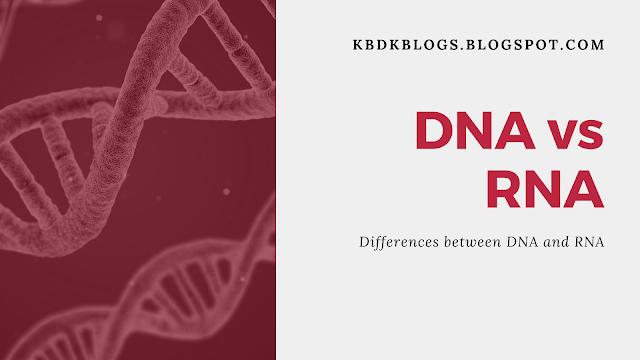Neet Cracky: The major differences between DNA and RNA
 |
| Neet Cracky |
I know that Google is flooded with many results for this query about the differences between DNA and RNA but I would like to shortlist my points and give you the aptest information required for board exams and other competitive exams. Let's get started with the topic.
Let's start with the basics we know that DNA is abbreviated as Deoxy Ribo Nucleic acid and RNA is abbreviated as Ribo Nucleic Acid. You might have wondered why do we study DNA and RNA which are too small to be seen by the naked eye.
- DNA was first identified by Friedrich Miescher in the late 1860s but in the 1950s DNA was discovered by James Watson and Francis Crick.
- Friedrich Miescher a Swiss physician and biologist discovered RNA in 1868. He named nucleic acid as ' Nuclein '.He was the first scientist to isolate Nucleic acid.
- In 1889 a scientist known as Altman named nuclein to nucleic acid.
- The length of all the DNA present in the human body is 600 trillion miles.
Differences
- DNA consists of 2-Deoxyribose sugar whereas RNA consists of Ribose sugar. Let's look at the molecular structures of Deoxyribose and Ribose sugars.
 |
| Fig: Molecular structure of Ribose and Deoxyribose |
 |
| DNA vs RNA Source: ThoughtCo |
- DNA is stable under alkaline conditions whereas RNA is unstable under alkaline conditions.
- DNA is responsible for storing and transferring genetic information, while RNA directly codes for amino acids and acts as a messenger between DNA and ribosomes to make proteins.
- DNA uses nitrogen bases such as adenine, thymine, cytosine, and guanine. Whereas in RNA nitrogen base uracil differs from thymine when we compare it with DNA.
- DNA is self-replicating whereas RNA is synthesized from DNA on an as-needed basis.
- DNA is susceptible to UV damage whereas RNA is relatively resistant to UV damage.
- DNA is base pairing with adenine-thymine and guanine-cytosine, RNA is base pairing with adenine-uracil and guanine-cytosine.
- DNA is only present in a higher level of the organization whereas RNA is present in both higher and lower levels of the organization making it present in extremely small microbes and archaea.
- DNA has a double helix structure whereas RNA forms a single strand-like helix structure. Sometimes RNA forms a double-stranded structure in some viruses.
- DNA is made up of Deoxyribose sugar-phosphate backbone whereas RNA is made up of Ribose sugar-phosphate backbone.
- DNA consists of a base pair of a nucleobase(Nitrogen base) whereas RNA only contains a single pair of nucleobase.
- DNA is much longer than the polymer of RNA whereas RNA molecules are variable in length but much shorter than long DNA polymers.
- DNA is found in the Nucleus and also present in Mitochondria whereas RNA is formed in the nucleolus and is moved to specialized regions of the cytoplasm depending on the type of RNA formed.
- DNA undergoes transcription whereas mRNA undergoes translation.
- According to some scientists, RNA was first formed but some suggest that DNA is first formed.
- RNA is used as a catalyst in a reaction whereas DNA is not used as a catalyst in a reaction.
- Mutation does not occur quickly in DNA whereas Mutation occurs quickly in RNA.
- DNA is rarely pathogenic whereas RNA is mostly pathogenic.
A tip for writing competitive exams and board exams is to overcome your fear that if you take a chance and it ends in failure. So don't postpone your chances to the end otherwise you would regret the chances you didn't take even if you did not succeed in your chance remember the famous quote that "Failure is the milestone to success".
 |
| Get motivated by reading these quote |
All the best viewers for your help in making my blog successful and I will now post more posts to keep all the readers engaged with new content. Waiting for your valuable comments.

